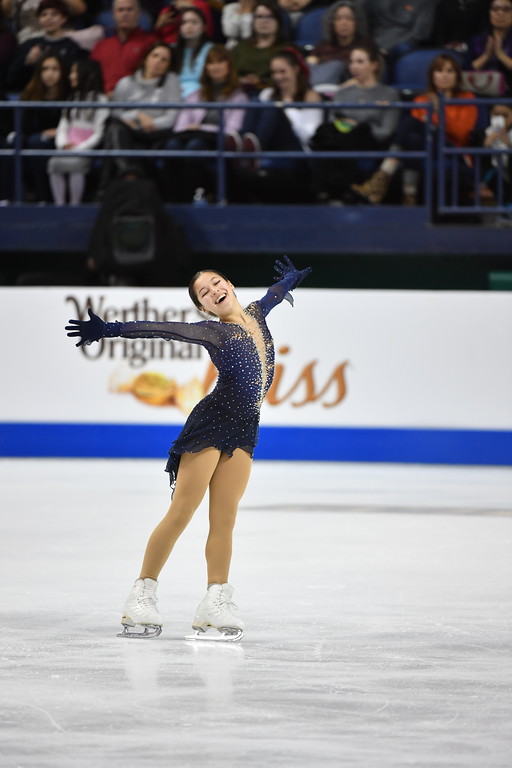Ashley Collman Feb 1, 2020
Casual followers of figure skating would know that the US hasn’t had a competitive ladies program in years. Long are the days of Tonya Harding, Michelle Kwan, and Sasha Cohen.
But that looks set to change by the time the next winter Olympics rolls around in 2022, thanks to a 4-foot-10, 14-year-old girl from the Bay Area.
Last year, Alysa Liu became the youngest woman ever to win the US Figure Skating Championships at the age of 13. She defended her title last week, making history again as she became the first woman to land a quadruple jump at nationals.
She also pulled off two triple axels, a jump so hard that only two American women have been able to land it in international competition, Harding and 2018 Olympian Mirai Nagasu.
Business Insider spoke to American skating greats Adam Rippon and Tara Lipinski to explain just how difficult Liu’s performance was, and what the future has in store for the phenom.
The ‘Simone Biles of figure skating’
Rippon, who helped the US win bronze in the team event at the 2018 Pyeongchang games, said Liu has the potential to be become the “Simone Biles of figure skating.”
“Alysa does things so easily, but if you’re an average viewer, you almost don’t appreciate how difficult and revolutionary the program that she’s putting out is,” he said.
Olympic gold medalist Lipinski, who was commentating on NBC Sports during last Friday’s finals, called Liu’s performance “mind blowing.”
“We haven’t seen a US skater with this much potential. We’re watching a world champion or an Olympic champion in the making,” Lipinski said.
Lipinski added that not only is Liu landing quad jumps, but she’s doing the one that’s considered the hardest: the quad lutz.
America’s ‘answer to Russia’
Both described Liu as America’s “answer to Russia,” which has dominated the sport in the last two Olympics.
Lipinski traced Russia’s rise back to one of the biggest skating scandals, the fixing of the pairs’ figure skating competition at the 2002 Winter Olympics in Salt Lake City. A French judge said she had been pressured to vote for Russian pair skaters Yelena Berezhnaya and Anton Sikharulidze, but later withdrew her claim. The international skating union banned that judge and the head of French skating for three years as punishment.
After the scandal, the rules concerning scoring were changed in Russia, and the new rules incentivized skaters to take more risks and attempt more difficult jumps.
Where once women never even attempted to do quadruple jumps, and triple axels were exceedingly rare, they are now becoming almost necessary to compete at the elite level.
Lipinski pointed to three Russian women in particular — Alena Kostornaia, Alexandra Trusova, and Anna Shcherbakova— who are regularly pulling off quadruple jumps or triple axels in competition.
Rippon said Liu isn’t just on the same level as these Russian athletes, she’s more well-rounded because the two girls landing quads (Trusova and Shcherbakova) aren’t attempting triple axels, too.
“So that kind of puts Alysa at an advantage,” he said.
“There’s no other US lady out there right now who can compete with them on that level,” Lipinski said.
How she could be a gold medal threat at the Olympics
But difficult jumps aren’t the only part of the scoring in figure skating. There’s also the component score, which judges a skater’s “artistry.” Both Rippon and Lipinski said that Liu has some work to do on this.
Lipinski pointed out how the best Russian skater of the moment, Kostornaia, has been beating her two teammates who have quad jumps thanks to her higher artistic score (the hardest jump she does is the triple axel).
“It’s finding this balance and it does take time to sort of learn how to be the complete package,” Lipinski said. “I think for Alysa, she needs not only to add more quadruple jumps but to make those jumps very clean.”
“I think Alysa is still building that momentum to create moments where you feel things, sort of in the vein of Michelle Kwan. But I think she is on her way to doing that,” Rippon said, adding that Liu is also working with one of the best skate choreographers.
Rippon said that he thinks Liu will “100%” be a gold medal threat if she stays healthy in the two years leading up to the next winter Olympics.
“I think that when we look ahead, especially to the way the rules are set up right now, Alysa is sort of at this perfect timing in her career. When she’s 16 — which seems to be sort of a golden age for ladies figure skating — that she really could be a medal threat, if not a gold medal threat at the Olympics in Beijing.”
Lipinski called it a “really exciting” time for US ladies’ figure skating.
“I think that Alysa is not only going to have a successful future and possibly eyeing an Olympic gold medal, but I think she’s redefining what ladies skating is in the US,” Lipinski said.
She added: “I think we’re going to see a lot of other young skaters coming up that are pushing their technical bar up to meet hers. So I think it’s going to be very interesting and exciting over the next few years, to see what’s coming out of those low levels of novice juniors.”


